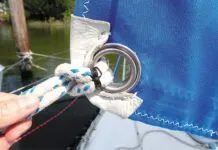Lots of confusion has arisen over the use and functionality of personal locator beacons (PLB) and automatic identification system (AIS) devices. Both can increase your odds of survival but do so in very different ways. The PLB is a diminutive EPIRB and functions in exactly the same manner as its big brother, the EPIRB. Details of how 406 Mhz digital distress signals are handled globally and the response they elicit are outlined in the article “Upgrading Sarsat,”.
AIS beacons promulgate a short-range, line-of-sight signal that will show up on a nearby (within 2-3 miles) vessel’s AIS display. More modern receivers display the signal as an MOB icon, while older units may simply reveal an AIS target with no additional information.
One of the advantages of the system is that it gives the crew remaining on the vessel a real-time MOB position that can be displayed on the vessel’s MFD. This aid can guide the crew to the person in the water. However in heavy seas, the wave troughs, spray and breaking seas can further diminish the 2-3 mile range. The AIS beacon works best in calm winds and flat seas, when MOB incidents are less likely.

The PLB is a small compact device that engages a huge, multi-national search and rescue service. The beacons themselves have undergone an immense amount of lab and field testing and the number of actual rescues instigated by PLB signals dwarfs other personal beacon types. However, there’s no way for the crew of the vessel with an MOB to receive the position information from the Rescue Coordination Center (RCC). At best, this requires a secondary means of communication such as VHF or satellite link with the RCC. This approach worked well in Vendée sailor Kevin Escoffier’s rescue, but even with the new array of MEO satellites, there was less-than-pinpoint accuracy and some searching was necessary.
The bottom line is both of these systems have their value. Perhaps the ideal answer is to have both. For many it’s an issue of cost not bulk. There’s little inconvenience of tucking a PLB into your pocket and packing an AIS in your inflatable life jacket. However, neither device is a substitute for investing in good tether clips, installing jacklines, and getting accustomed to functioning in heavy weather, attached to the boat.
In the future, AIS tracking satellites (S-AIS), now keeping tabs on ocean going vessels equipped with AIS units(type B+ and A), will likely also be able to locate the next generation of AIS beacons. This will add a whole new aspect to distress signaling and rescue coordination.



































